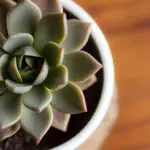Welcome to the enchanting world of succulents! These unique and vivid plants have taken the gardening community by storm, becoming a common household staple associated with modern, classy aesthetics. But what exactly is a succulent, and why are they so darn popular?
Rooting Down on What Succulents Are
Unlike traditional potted plants, succulents are characterized by their thick, fleshy parts that are specifically designed to retain water in arid climates or soil conditions. Their unique adaptation makes them extremely drought-resistant, originating from regions across the globe, including Africa, Central America, and the European Alps. And let’s not forget about their stunning variety in forms and colors, from the silky rosettes of Echeveria to the towering columns of cacti.
Popularity of Succulent Gardens
Succulents have risen in popularity for many reasons. For starters, they’re beginner-friendly. Suppose you’re someone who often forgets to water your plants or travels frequently. In that case, succulents won’t hold it against you. They’re resilient, low-maintenance, and can tolerate a bit of neglect – perfect for those with a record of being a plant assassin!
They also bring a unique aesthetic appeal to any living space. Succulents have the power to transform your garden or home into an oasis of tranquillity. They can be used as living works of art, adding a touch of sophistication and color to otherwise bland spaces.
Navigating Your Way to a Thriving Succulent Garden
In this beginner’s guide, we’ll share essential tips and tricks to help you create a thriving succulent garden. We’ll delve into topics such as selecting the right succulents for your environment, mastering the art of succulent care, and manipulating their growth to create mesmerizing garden compositions. Whether you’re completely new to gardening or just want to add some vibrant new additions to your plant family, this guide will give you everything you need to immerse yourself in the world of succulent gardens.
Is there anything more appealing than a succulent garden, bursting with color, texture, and charm? Let’s start by exploring a variety of succulents that can breathe new life into your outdoor space.
Invigorating Your Space with Aeoniums
Aeoniums are an eye-catching addition to any succulent garden. Unlike some other succulents that maintain a close-to-the-ground presence, Aeoniums stretch towards the sky with their long, skinny stems. Their perky rosettes, ranging in color from bright green to deep purple and even black, sit proudly atop these stems. They create a stunning contrast when paired with shorter, more sprawling succulents.
Experiencing the Versatility of Sedums
Speaking of more sprawling succulents, let’s dive into the world of Sedums. Regarded as true workhorses of the succulent garden, they put forth a trail of delightfully plump leaves. Sedums exhibit an impressive spectrum of colors, including shades of green, blue, and even gold. As if that weren’t enough, Sedums add a surprise pop of color to your garden when they bloom with tiny, star-shaped flowers.
Adding a touch of Elegance with Echeverias
Echeveria succulents are often referred to as “the belles of the ball” in any succulent garden. These dainty beauties form rosettes of tightly packed leaves, sitting pretty in shades of grey, blue, pink, and more. The most unforgettable feature? The stunning blooms that extend from lengthy stalks, catching anyone’s eye.
Dramatizing Your Garden with Sempervivums
For those after a pinch of drama in their succulent garden, look no further than Sempervivums. Also known as “hen and chicks,” these succulents form clusters of rosettes, where the “hen” is surrounded by her “chicks” — smaller rosettes circling the larger central rosette. Their unique growth pattern and pigments that intensify with cool temperatures give your space a dramatic appeal.
Indulging in the Unusual with Lithops
Capping off our list are Lithops- the weird, yet wonderful, part of your succulent garden. These little wonders, known as “living stones” for their peculiar, pebble-like appearance, introduce an element of surprise into your garden. Between the atypical shape and the vibrantly colored flowers that emerge from their tops, Lithops are sure to attract curious onlookers.
Regardless of which succulents you choose to include, designing a succulent garden is all about celebrating diversity and enjoying the unique traits each succulent brings. By exploring different types, you’ll create a garden that’s just as unique as it is beautiful. So why wait? Start planning your succulent garden today and bring a touch of the exotic to your doorstep!
The Basics of Succulent Garden Planning
If I asked you to imagine the perfect little oasis in your backyard, would it include a succulent garden? There’s no denying the charm these hardy plants bring. Their unique shapes, ease of care, and stunning color variety make them increasingly popular among gardening enthusiasts and home decorators. But to create such a garden that will thrive, a bit of planning is necessary. Let’s explore some key factors to consider, such as climate, sunlight exposure, soil type, and available space.
Climate and Your Succulent Garden
The first thing to keep in mind when you wish to start your own succulent garden is the climate. Succulents originate from arid and semi-arid regions, such as Africa and parts of South America. Their hardy nature enables them to withstand high temperatures and low rainfall. If you are living in an area with similar climate conditions, you can easily grow succulents outdoors. However, if you reside in cooler, wetter climates, it doesn’t mean you can’t nurture these little wonders. They can thrive indoors in your home or office and can be moved outdoors during summer.
Sunlight Exposure: A Key to Succulent Health
You’ve heard the phrase ‘as happy as a clam’, but we think ‘as jolly as a sun-bathed succulent’ might be more fitting. Indeed, sunlight is a vital factor for the well-being of your succulent garden. These lovelies prefer a generous dose of sunlight. For ideal growth, ensure they receive around 6 hours of direct sunlight a day. However, like our skin, succulents can get sunburned. So, on extremely hot days, some shade will come in handy.
Type of Soil: Let’s Get Down and Dirty
Consider the type of soil in your garden as if you were choosing your favorite ice-cream flavor. You got it! It’s that important. Succulents favor well-draining soil which mimics their natural, arid habitats. A soil mix with sand, pumice, or perlite incorporated into it works best as it allows the water to drain quickly, preventing root rot. Now you know why those cute little cacti in the sandy deserts do so well.
Space: The Final Frontier of Succulent Gardening
Dreaming of a massive, sprawling succulent garden? Or picturing a tiny, cute arrangement on your windowsill? Regardless, one other crucial planning factor when creating your succulent garden is space. Succulents, although quite modest in their space needs, do appreciate some elbow room. They need enough space to grow without overlapping. Overcrowding can hinder their growth and lead to moisture retention (something your succulent buddies don’t like). Hence, when planning, be mindful of the size and growth pattern of your chosen succulent varieties.
Planning may seem like a daunting or boring task at first, but as you can see, it’s actually the key to creating and maintaining a thriving, happy succulent garden.
When it comes to creating your very own succulent haven, the joy is definitely in the journey— and we’re here to guide you through it. So, let’s jump right into this step-by-step guide to planting your succulent garden. A little heads up though, by the end of this section, you will be itching to get your hands dirty!
Step 1: Choosing the Perfect Location
Your favorite little green buddies, succulents, are sun lovers. They thrive in locations which get a good blast of daily sunlight. So, the first step? Scout out the sunniest spot in your home or garden. An east-facing window ledge or balcony that gets six hours of sunlight would make an idyllic locale for your soon-to-be blossoming succulent garden.
Step 2: Selecting Suitable Succulents
The wonderful thing about succulents is the sheer variety available! From the small, delicate echeveria to the robust, regal agave, there’s a succulent out there for every garden and gardener. Consider the hardiness of each variety, and make sure they’ll be comfortable in your area’s climate conditions.
Step 3: Preparing the Perfect Soil
No succulent garden is complete without well-drained soil. Why, you ask? Well, succulents, unlike some other plants, aren’t fans of “wet feet”. They like their roots relatively dry. So, be sure to avoid heavy, clay-based soils. Instead, opt for a gritty, sandy soil mix specifically designed for succulents and cacti.
Step 4: Proper Planting and Spacing
And now for the main event: planting! Here’s where the real fun begins. Dig a hole that’s just about the right size to nestle your succulent in. You don’t need to go too deep—most succulents have relatively shallow root systems.
As for spacing, this isn’t an exercise in succulent claustrophobia. Succulents need some personal space to grow and not compete for nutrients. A handy rule of thumb? Leave at least an inch or two between each succulent plant. Trust us, they’ll thank you later.
Step 5: Succulent Care and Maintenance
The last (and in my opinion, the easiest) step entails watering, feeding, and generally showering your succulent garden with love and care. Succulents, being desert plants, are pretty low-maintenance—as long as you don’t over-water them! Watering your succulents once a week generally does the trick.
And there you have it! Five easy steps to creating your very own succulent garden. But remember, every garden is unique, just like its gardener. The key is to experiment, learn and enjoy every step of the journey. Happy succulent gardening!
So you’ve planted your succulent garden, and it’s looking great! But the true test of your green thumb isn’t just in the planting—it’s in the caring. Let’s dive into how to properly care for the beauties you’ve just planted.
Caring for Your Succulent Garden: Watering 101
Let’s start with watering. While it’s true that succulents don’t need tons of water, they do require more than you might think. Think of them as camels, they store water in their leaves, but contrary to popular belief, that supply isn’t inexhaustible. Here’s the trick: water your succulent garden thoroughly, letting the water run out from the bottom, then let the soil dry completely before watering again. Over-watering is a common mistake, creating a soggy environment that can lead to root rot—a succulent gardener’s worst nightmare!
Addressing Sunlight Needs
Onto the reigning king of plant needs: sunlight. Just like us, succulents love to sunbathe. They prefer bright, indirect light. But be wary, too much direct sunlight could cause your succulent garden to sunburn – yes, plants can sunburn too! It’s all about striking that sunny balance. A south-facing window or a spot in your porch that gets a few hours of morning sun would be ideal.
Freezing? No, Thank You: Winter Protection
As winter approaches and temperatures drop, your succulent garden might need some extra love. Most succulents are not big fans of the cold. Secure your succulent’s winter survival by moving them indoors or providing some type of covering when frost is predicted. Successfully carrying your succulent garden through harsh winters is a true green thumb victory!
Dealing with Unwelcome Visitors: Pests
Finally, let’s address pests. Succulents, with their juicy, plump leaves, can sometimes turn into all-you-can-eat buffets for insects and pests. Regularly inspect your succulent garden for signs of mealybugs and gnats. If you spot these unwelcome guests, a gentle spray of insecticidal soap or a mixture of water and dish soap should help. Remember, an ounce of prevention is worth a pound of cure when it comes to keeping your succulent garden safe from pests.
To sum up, caring for your succulent garden requires a keen eye and some extra attention, but with these tips in hand, you’re on your way to nurturing a garden that thrives!
Looking to create your own slice of paradise with a succulent garden? You’re in the right place! In this section, we’ll get your creative juices flowing with various design ideas for your succulent garden. Whether you prefer a trendy aesthetic or classic arrangements, we’ve got you covered. We’ll also step outside the box and explore some unconventional succulent styling ideas. Get ready to transform your garden into a little oasis that succulents – and you – will love.
Trendy Succulent Garden Designs
Let’s kick things off with what’s hot in the world of succulent gardens. Vertical gardens, also known as “living walls”, have become a popular way to showcase succulents. This unique design concept utilizes vertical space to plant succulents in wall-mounted containers, creating a striking display that literally transforms your wall into a garden!
Another trendy idea is to integrate succulents into your outdoor furniture. Picture this – a tabletop covered in a lush spread of different succulent species. It’s practical, effortlessly cool, and sure to leave your guests in awe.
Classic Arrangements for a Traditional Succulent Garden
For those who fancy a more traditional approach, consider a classic rock garden arrangement. This design entails planting succulents amongst rocks, which serve as a magnificent backdrop while also helping to regulate soil temperature and moisture. Pair different textures and colors of stones with various succulent species for a dynamic, visually-appealing display.
Terrariums also exhibit classic charm. These small, glass-enclosed gardens offer an ideal environment for humidity-loving succulents, and they can be beautifully arranged on desks, bookshelves, or windowsills. Design a miniature world by adding adorable fairy garden accessories like mini houses or tiny bridges into your terrarium setup.
Unconventional Ideas for Your Succulent Garden
Ready to get a little wild with your garden design? Why not repurpose an old birdcage, a teacup, or even a pair of shoes to plant your succulents? With a little bit of creativity, almost any object can become an eye-catching home for your succulents.
Alternatively, try out monochrome gardening. This cutting-edge design concept involves arranging your garden with succulents of the same color for a sleek, stylish look. All-green succulent gardens, for instance, can be surprisingly calming and breathtaking.
From trendy designs to classic arrangements and unconventional ideas, there are countless ways to style your succulent garden. The idea is to express your personality and taste while providing a thriving environment for your succulents. Enjoy the creative process and brace yourself for the endless compliments on your fabulous succulent garden!
Common Mistakes in Growing Succulents
Never underestimate the charm of a well-maintained succulent garden! However, as any expert gardener will tell you, growing succulents isn’t quite a walk in the park! There are some hidden potholes on this journey that could turn your beautiful garden into a desert fiasco. Let’s explore some of these common mistakes and figure out ways to dodge them.
Overwatering Your Unforgiving Succulent Garden
Here’s the irony of gardening – more watering doesn’t necessarily mean healthier plants! In fact, succulents require relatively little water compared to their green counterparts. Picture this, you’ve got a lush, little succulent sitting pretty on your kitchen window, tempting you to pour in that nurturing watering can. Hold on there! Succulents, unlike most plants, actually thrive in drier conditions. Drenching succulents in water can lead to root rot and can ultimately end up collapsing your entire succulent garden. It should be watered only when the soil is completely dry. Remember, when it comes to watering- less is more!
Ignorance About Proper Lighting
Another common but disastrous succulent mishap is improper lighting. People often place their succulent in a shady corner or expose it to harsh, direct sunlight all day. Neither is a smart move for your succulent garden. Succulents love indirect, bright light. It’s like their version of getting a healthy tan! Too much direct sunlight and they can get a nasty sunburn. Too little light and your succulent will start stretching towards the light source. The perfect spot? Near a window with filtered light or in a location that gets morning sun and afternoon shade.
Misunderstanding Succulents’ Respiratory Needs
Did you know your succulent garden breathes differently? Unlike most of their leafy companions, succulents breathe in carbon dioxide at night, not during the day. Hence, it’s not the best idea to keep them cooped up inside an air-tight glass container. Yes, those glass terrariums with thick layers or poor-draining soil might make an Instagram-worthy Pretty Little Liars-themed gift, but trust us, for a thriving, happy succulents garden, stick to the breathable clay or ceramic pots.
So, next time you’re craving to see the magical transformation of tiny succulents into a vibrant succulent garden, make sure you dodge these common potholes! Happy gardening!
The Amazing Benefits of a Succulent Garden
When it comes to hobbies that combine elegance, beauty, and practicality, crafting a succulent garden is second to none. But what exactly are the perks of embracing this gorgeous green hobby? Let’s spell out some of the major game-changers here.
Low Maintenance Marvels
One of the outstanding benefits of having a succulent garden is its impressively low maintenance demand. Succulents are hardy, resilient plants that require little attention, making them perfect for both seasoned gardeners and those with not-so-green thumbs. Remember your vacation when you were worried sick about your garden wilting away in your absence? With a succulent garden, you can chuck those worries aside. A week or two without water doesn’t spell disaster for these botanical troopers. The ease of maintenance makes a succulent garden the ideal choice for everyone.
Exceptional Aesthetic Appeal
This is where a succulent garden truly sits in a league of its own! They bring an aesthetic charm that’s truly unparalleled. From verdant greens to vibrant violets, they flaunt a stunning spectrum of colours. And let’s not even get started on the wide range of shapes and textures. Got an empty corner on your patio? Fill it with a collection of succulents and watch the space transform into a beautiful, living piece of art. Whether inside your house or in your outdoor spaces, a succulent garden adds a tasteful touch of natural beauty that can’t be mimicked.
Environmentally-Friendly Choice
Our beautiful planet could do with a bit more green, and every succulent garden contributes to the cause. Succulents help improve air quality by filtering out toxins and releasing oxygen – a much-needed process, especially in our increasingly urbanized environments. What’s more, these little green champs are champions at conserving water. These desert dwellers are pros at storing water in their leaves, meaning they require less frequent watering. By choosing a succulent garden, you’re not just making a choice for your aesthetics or ease, you’re also making an eco-friendly choice to help the environment.
Suffice to say, starting a succulent garden offers a bouquet (pun intended!) of benefits. Whether you’re someone who struggles to keep plants alive or someone with a masterful green thumb, succulents offer a rewarding and enriching garden experience. So, are you ready to unleash your horticultural creativity and tap into the amazing benefits of a succulent garden?
Frequently Asked Questions About Succulent Gardens
As a gardener — whether expert or not — you have probably asked, “how to properly water a succulent?” or “how to select the right succulent for my garden?” and even “how to deal with pesky pests in my succulent garden?” Here, we’ve collated those common queries and answered them in a jiffy to help you create a thriving succulent garden.
How Often Should I Be Watering My Succulent Garden?
Succulent plants are dainty, but they’re not quite as fragile as we think. Too much water is often the downfall of many succulent gardens. As a general rule of thumb, it’s good to water your succulents once the soil is totally dry, which could mean watering once a week in summer and less often in winter. Essentially, the frequency depends on the climate and the type of succulent. Picturing a cactus surviving amidst the arid desert could guide you.
How Do I Choose the Right Succulents for My Garden?
Choosing the right succulents for your garden can be as straightforward as selecting your favorite color. However, for a thriving succulent garden, it’s crucial to think about the garden’s location, exposure to sunlight, and the succulents’ compatibility with each other. Reiterate the fact that not all succulents are identical, some prefer shaded areas while others bask in the sun. It’s like teaming up for a group project, you’d want members who work well together, right?
How Can I Deal With Pests in My Succulent Garden?
We acknowledge that dealing with pests can be downright exasperating. These little culprits, such as aphids, mealybugs, or beetles, can wreak havoc on your succulent garden if not controlled. But don’t panic! You can use neem oil, insecticidal soaps, or even introduce natural predators—like ladybugs or lacewings—into your garden. It’s like hiring security guards for your succulent garden. Although, prevention is always better than cure — regularly checking your plants for signs of pests could save them from irreversible damage.



